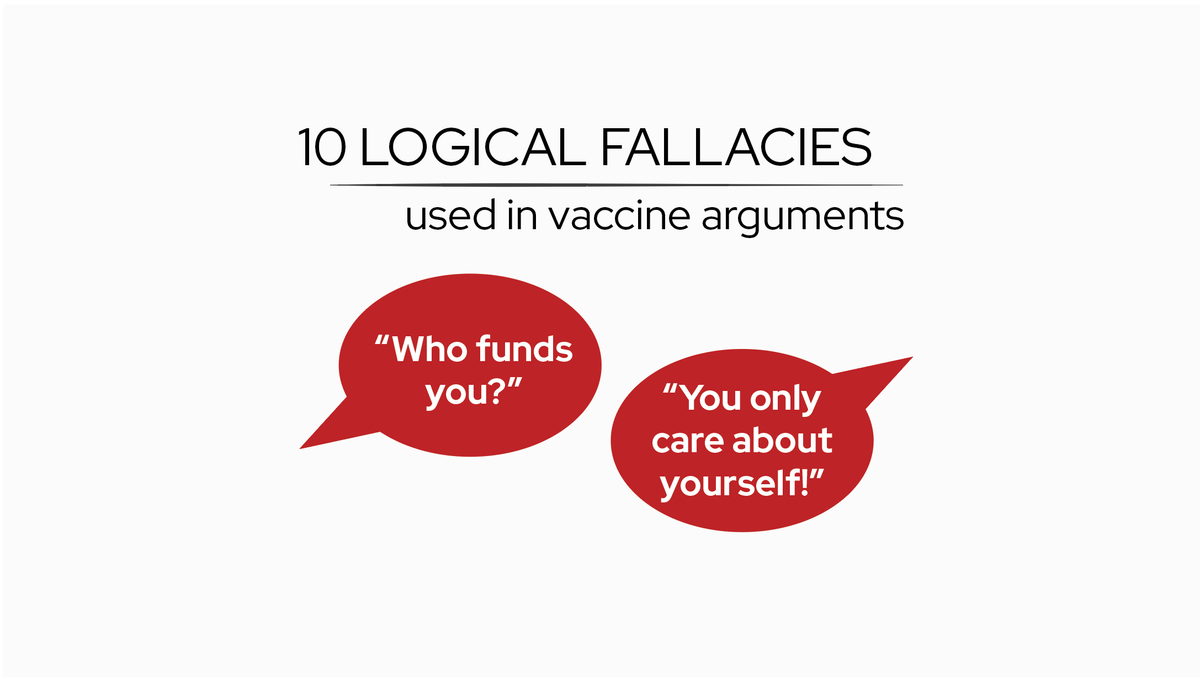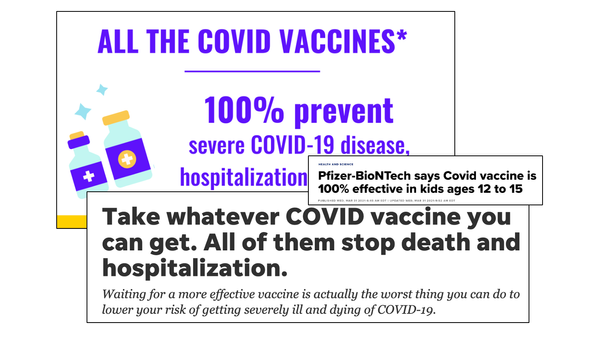10 logical fallacies used in vaccine arguments

Arguments about vaccines are often rife with logical fallacies. Many logical fallacies, at their root, are oversimplifications. They are appealing because they make something complex, like vaccine safety or the efficacy of vaccines, into something very simplistic that is easy to understand. However, that oversimplification often leaves out important details, which can lead to inaccurate conclusions.
Over the last two months, I’ve been going through common vaccine arguments that are rooted in logical fallacies and dissecting the flaws in each one. I’ve been posting them on instagram as I go, and this post collects them all in one place. It’s important to note that logical fallacies are used by people arguing all sorts of things, including people arguing for vaccination. And, just because someone uses a fallacy in their argument doesn’t automatically mean they’re wrong — (that’s the fallacy fallacy!) It simply means they haven’t provided adequate evidence supporting their argument, but that evidence may in fact exist.
What are logical fallacies?
My good friend, Dr. Gretchen Ellefson (Assistant Professor of Philosophy) regularly teaches critical thinking classes, including a segment on logical fallacies. (When I’ve been stuck identifying a fallacy for this series, she is the one I ask!) Here is her basic intro to fallacies:
“First, at a basic level, fallacies are flaws in reasoning or faulty forms of reasoning. What we mean when we say this is that people have arguments in mind when they form beliefs, meaning that they have reasons supporting a given conclusion. An argument has a fallacy when the reasons fail to do their job–they don’t actually support the conclusion.
The second thing is that fallacies are super normal and common and everyone uses them. The reason we want to talk about them is because recognizing where fallacies come in can help us do better at making sure we have good reasons for what we think is true. This means that when we see people using fallacies, we should recognize that this is a normal human thing, not a sign of stupidity.
That said, fallacies do tend to track forms of reasoning that human brains, for whatever reason, find compelling, even though they shouldn’t be. This means that fallacies CAN be used in really manipulative ways. If someone wants to convince their audience of something, and they know that there aren’t good reasons for their audience to accept that thing, then they may look for ways to use these kinds of patterns of reasoning which people will be less likely to immediately recognize as flawed.”
10 examples of logical fallacies in vaccine arguments
#1: The false dichotomy fallacy
“If the COVID vaccines work, then why are vaccinated people getting COVID?”
This is an example of the false dichotomy fallacy, which takes a complex topic and falsely asserts there are only two possible explanations, when in fact more explanations exist. This one, also referred to as “binary thinking,” has shown up a lot on various topics around the pandemic. The false dichotomy tries to win an argument with a false position by proposing that the only other explanation is something that is clearly false, essentially forcing the choice between two incorrect options, when in reality, more option exist.
For example, some suggest that the presence of breakthrough infections proves that COVID vaccines don’t work. This is a false dichotomy, as it suggests there are only two possible options for vaccine efficacy: (1) the vaccines stop 100% of infections all the time or (2) the vaccines are completely ineffective. In reality, neither of these options is correct. Vaccines reduce the risk of infection, hospitalization, and death (what scientists mean when they say the vaccines ‘work’), but they don’t completely eliminate it (some breakthrough infections will happen). Just like most other medical interventions, the efficacy of vaccines is not all or nothing. For a more in depth discussion on breakthrough infections, check out this post. And for a discussion on why each person’s decision about vaccination impacts those around them, check out this post.
#2: The appeal to authority fallacy
“Here’s a doctor who says you’re wrong.”
The appeal to authority fallacy asserts that authority figures (experts) must be right. Of course, this is not always true; reality does not bend to the will or whims of people with credentials. Right now I think this one is especially confusing, because the scientific community says “trust the experts!” but then occasionally someone with credentials says something a bit weird, then they say “ignore them!” The rules of science are this: the best data and the best analysis win. It does not matter who is saying it; the data and analysis are all that really matter. Often, scientists with more credentials are better at recognizing good data and analysis, so that is why it usually makes sense to “trust the experts!”
But sometimes an expert or two might latch onto bad data for a variety of reasons (they got overly attached to their hypothesis and want to be right, they have a financial conflict of interest, the science conflicts with their ideological views, they need an audience, they are speaking outside their area of expertise). In these cases, it’s best to ignore them, even though they have a fancy degree. A degree doesn’t prove someone is right; sound data does. So if you don’t know how to judge the quality of the data and analysis for yourself, how do you tell the difference? My best advice is to look at what the majority of scientists are saying — the consensus of the majority of scientists (who have expertise on the question at hand) will usually lead you to the right answer.
#3: The false equivalence fallacy
“Why aren’t doctors promoting diet and exercise like they are vaccines?”
The false equivalence fallacy attempts to make two things seem equivalent that are not by emphasizing shared features and ignoring key distinct differences. For example, some have proposed that healthy diet and exercise should be promoted along side vaccination as an equivalent method of reducing risk of illness and death from COVID.
While it’s true that healthy diet and exercise are good for you, and it’s also true that diseases that are in part caused by poor diet and exercise are associated with increased risk of poor outcomes from COVID, it’s false that a healthy diet and exercise are equivalent to vaccination. There are many key differences between the two (for example, vaccines train the immune system to recognize the virus, diet and exercise do not; vaccines work quickly, the healthy effects of diet and exercise are best achieved when implemented chronically; vaccines are free and easy to receive; a healthy diet and exercise can take significant effort to integrate into one’s life.) Is it important to eat healthy and exercise? Absolutely. Do doctors promote it generally? Of course. But when it comes to protecting people from COVID, diet and exercise alone are not equivalent to vaccination.
#4: Sealioning
“I’m just asking questions.”
While many people have genuine questions that are worth answering, some use the pretense of questions to engage in bad faith debate. If someone has a “question” but does not listen to the answer when provided, chances are they don’t truly want to learn from the person they are questioning, but rather want to share their view and argue.
This behavior, when repeated ad nauseum, is also known as “sealioning,” where a person repeatedly asks questions or demands evidence, pretending to being engaged in honest enquiry but refusing to be satisfied by any response provided. The goal is ultimately to spread doubt through questions and/or harass the person who is being questioned to the point of exhaustion, all while maintaining a pretense of humble enquiry. Ultimately, if the one being questioned stops responding (as is wise), the questioner may erroneously conclude they have won the argument because many of their bad faith enquiries remained unrebutted. While not a formal fallacy, it is a common rhetorical strategy that gets its name from the sea lion in this comic, which illustrates the behavior.
#5: The post hoc fallacy
“VAERS shows thousands of people are dying from the COVID vaccines!”
The post hoc fallacy (formally the ‘post hoc ergo propter hoc’ fallacy, which is Latin for ‘after this, therefore because of this’) is a fallacy that assumes that if event A comes before event B, event A must have been the cause of event B (without any additional evidence of causality). This is a version of the “correlation implies causation” argument. Misinterpretations of the VAERS database are a great example of this. Many people assume that if a negative health event occurred shortly after vaccination, that proves the vaccine caused it. This is false and is an example of the post hoc fallacy, because temporal association alone is not enough evidence to determine if one event is the cause of another. Statistically, we know there will be some negative health events that occur after vaccination purely due to chance.
It is unreasonable to assume that with millions of people getting vaccinated, nobody will have any unconnected negative health events within the weeks following vaccination. That would be a statistical anomaly. From VAERS reports alone, it is not possible to determine if vaccination was the true cause. To tell the difference between expected coincidences versus true vaccine side effects, VAERS reports are verified and studied to determine if there are health events that are occurring more often after vaccination than would be expected from background levels (more details here). This is how VAERS is used properly and why it’s such a useful vaccine safety monitoring tool. In fact, there is one vaccine I *didn’t* get because of VAERS reports that were used correctly. That story is told here.
#6: The straw man fallacy
“You said the vaccines are safe, but clearly there are side effects.”
The straw man fallacy occurs when someone gives the impression of refuting an argument by intentionally or unintentionally mischaracterizing it (often via over-simplification), attacking the false, oversimplified version of the argument instead of addressing the original. Side effects are a great example. When a doctor prescribes a drug like aspirin, says it’s safe, and discusses possible side effects, most people understand the statement that the drug is safe is not a guarantee of zero side effects.
Rather it means that common side effects are tolerable, the risk of serious adverse events is exceedingly low, and the benefits of the drug for that patient outweigh these risks. Likewise, when a doctor says “this vaccine is safe,” disussing possible side effects and how the benefits of vaccination outweigh the risks, they are doing the same thing. However, the statement that “vaccines are safe” is often taken out of this nuanced discussion and mischaracterized to be a promise that vaccines don’t have any side effects, which is obviously untrue. This is a strawman argument because it takes a nuanced statement about vaccine safety (risk vs benefit, known side effect profile, etc.) and overly simplifies it (vaccines don’t have side effects), then refutes the false, simplified version without addressing the original argument.
#7: The ad hominem abusive fallacy
“You only care about yourself!”
One of the most common logical fallacies widely used on both sides of vaccine arguments is the ad hominem abusive fallacy. An ad hominem argument (which means “to the person”) is when someone doesn’t directly address the topic under discussion (i.e. ‘how well do the COVID vaccines work?’) but instead criticizes the person who made the statement.
The abusive form of this fallacy takes the form of a personal attack or insults (‘you clearly don’t care about anyone but yourself!’) The switch from reasonable debate to ad hominem fallacy occurs when a person stops attacking the argument and starts attacking the arguer. It is fair and valid to disagree in argument and state your reasons for doing so. However, when this switches over to personally attacking the character, appearance, or motivations of the person you are arguing with, not only is that mean, it is illogical. For example, name-calling doesn’t tell anyone anything meaningful about vaccine efficacy, and is not a logically valid rebuttal to a statement about vaccine efficacy. Furthermore, because it’s hurtful, it often leads to people becoming defensive and less willing to have a nuanced discussions, which isn’t helpful.
#8: The anecdotal fallacy
“No one I know had side effects from the vaccine – there are no side effects”
The anecdotal fallacy occurs when people use their limited personal experience to make sweeping conclusions about a given topic. It is an exceedingly common fallacy to commit, and nearly everyone has done it at one point or another. We are used to making conclusions based on our personal experiences because in many areas of life, anecdotal evidence (evidence from personal experience) is the only kind of evidence we have. However, when it comes to things like vaccine side effects, personal experience alone is not enough to decide if a symptom is caused by a recent vaccination or something else.
Imagine a person had scheduled to get a COVID vaccine on Monday, but then had to cancel last minute. Now imagine later that day, they happened to have a thoroughly obnoxious twitch in their hand. If they had gotten vaccinated, they may have been tempted to conclude the vaccine caused the twitch, even though it was going to happen anyways and would have been coincidence. When millions of people are getting vaccinated, coincidences like these are statistically bound to happen. However, some symptoms are truly caused by vaccines. The anecdotal fallacy assumes that personal experience is enough to know when it’s coincidence and when it’s not. This isn’t true: in order to truly know which symptoms are caused by vaccines, it needs to be studied systematically across large groups of people, not deduced from limited stories.
#9: The red herring fallacy
“Who funds you?”
“Who funds you?” is very commonly posed to people discussing vaccines, and utilizes three different logical fallacies. The first is the red herring fallacy, which tries to win arguments not by discussing the issue at hand (vaccines), but by shifting the discussion to a different topic (an alleged funding source). A red herring fallacy occurs anytime someone intentionally or unintentionally brings up a topic that is only tangentially related to the topic at hand that serves as a distraction and provides no useful information. Because “who funds you?” also carries a sting of accusation (”you’re dishonest and corrupt!” it also falls into the category of the ad hominem abusive fallacy.
It is also an ad hominem circumstantial fallacy, which tries to dispute the claim not by providing any direct evidence the claim is wrong, but by accusing the arguer of being biased. While it is important to consider conflicts of interests and biases, accusing someone of bias is not a logically valid rebuttal to an argument about data. If they truly are biased and that bias is influencing their interpretation of the data, then a logically valid rebuttal would point out why the data interpretation is wrong, not simply attack them with accusations of bias. Finally, this accusation is often directed at scientists, with some claiming “corruption” if they discover the scientist is “funded” by an organization like the National Institutes of Health. This fails to recognize that it is standard for scientists to receive grant funding to do their research – this is not a sign of something nefarious, but rather is a sign that the scientist has a job.
#10: The base rate fallacy
“50% of COVID hospitalizations are vaccinated people!”
The base rate fallacy occurs when people try to estimate the chance of something happening based only specific examples in front of them, ignoring the background levels of those events in the population. For example, suppose two COVID patients were admitted to the hospital, one who is vaccinated and one who is not. If we only focus on this information, we might conclude that there is no difference in the rate of hospitalization for COVID between vaccinated versus unvaccinated people. But what if I told you this hospital was located in a town of 100 people, where 98 of them were vaccinated and only 2 were not?
This dramatically changes our interpretation. Now we know only 1 in 98 vaccinated people are hospitalized for COVID in this town, while 1 in 2 unvaccinated people are hospitalized for COVID. Ignoring the background rates of vaccination in the population, which highly influences the interpretation of the data, is an example of the base rate fallacy — it’s impossible to interpret numbers about the percent of COVID hospitalizations who are vaccinated without taking into account these background rates. If this were a math test and we were asked to figure out how well the vaccines are working, but the only information we were given was ‘50% of hospitalized COVID patients are vaccinated,’ we couldn’t answer the test question. We’d have to walk up to the teacher and tell them that more information is needed. For more details, check out this post I wrote for Dear Pandemic on this topic.




